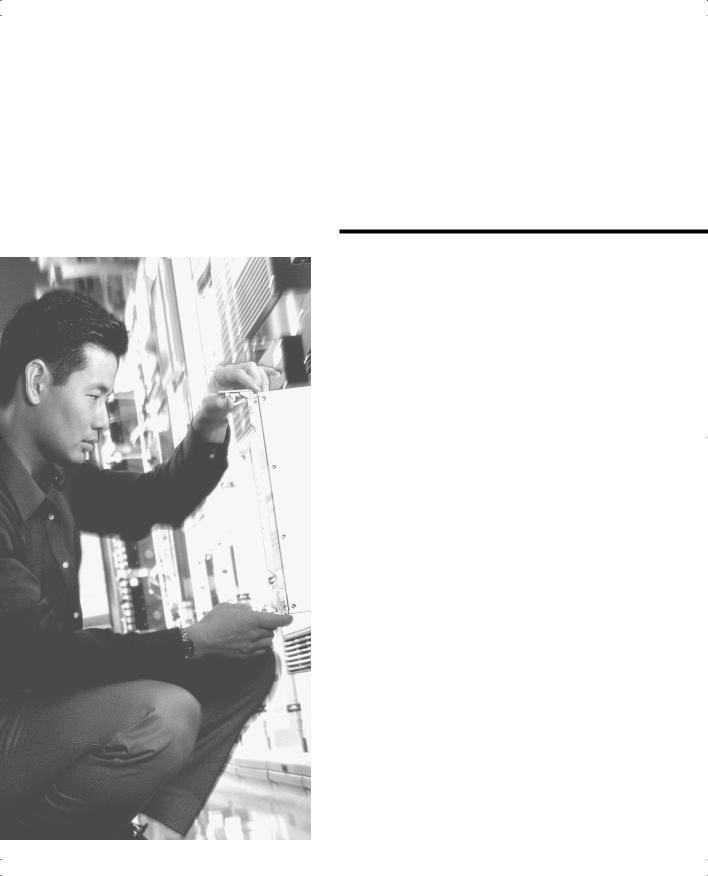
- •Warning and Disclaimer
- •Feedback Information
- •Trademark Acknowledgments
- •About the Author
- •About the Technical Reviewers
- •Dedication
- •Acknowledgments
- •Contents at a Glance
- •Contents
- •Icons Used in This Book
- •Command Syntax Conventions
- •Cisco’s Motivation: Certifying Partners
- •Format of the CCNA Exams
- •What’s on the CCNA Exams
- •ICND Exam Topics
- •Cross-Reference Between Exam Topics and Book Parts
- •CCNA Exam Topics
- •INTRO and ICND Course Outlines
- •Objectives and Methods
- •Book Features
- •How This Book Is Organized
- •Part I: LAN Switching
- •Part II: TCP/IP
- •Part III: Wide-Area Networks
- •Part IV: Network Security
- •Part V: Final Preparation
- •Part VI: Appendixes
- •How to Use These Books to Prepare for the CCNA Exam
- •For More Information
- •Part I: LAN Switching
- •“Do I Know This Already?” Quiz
- •Foundation Topics
- •Brief Review of LAN Switching
- •The Forward-Versus-Filter Decision
- •How Switches Learn MAC Addresses
- •Forwarding Unknown Unicasts and Broadcasts
- •LAN Switch Logic Summary
- •Basic Switch Operation
- •Foundation Summary
- •Spanning Tree Protocol
- •“Do I Know This Already?” Quiz
- •Foundation Topics
- •Spanning Tree Protocol
- •What IEEE 802.1d Spanning Tree Does
- •How Spanning Tree Works
- •Electing the Root and Discovering Root Ports and Designated Ports
- •Reacting to Changes in the Network
- •Spanning Tree Protocol Summary
- •Optional STP Features
- •EtherChannel
- •PortFast
- •Rapid Spanning Tree (IEEE 802.1w)
- •RSTP Link and Edge Types
- •RSTP Port States
- •RSTP Port Roles
- •RSTP Convergence
- •Edge-Type Behavior and PortFast
- •Link-Type Shared
- •Link-Type Point-to-Point
- •An Example of Speedy RSTP Convergence
- •Basic STP show Commands
- •Changing STP Port Costs and Bridge Priority
- •Foundation Summary
- •Foundation Summary
- •Virtual LANs and Trunking
- •“Do I Know This Already?” Quiz
- •Foundation Topics
- •Review of Virtual LAN Concepts
- •Trunking with ISL and 802.1Q
- •ISL and 802.1Q Compared
- •VLAN Trunking Protocol (VTP)
- •How VTP Works
- •VTP Pruning
- •Foundation Summary
- •Part II: TCP/IP
- •IP Addressing and Subnetting
- •“Do I Know This Already?” Quiz
- •Foundation Topics
- •IP Addressing Review
- •IP Subnetting
- •Analyzing and Interpreting IP Addresses and Subnets
- •Math Operations Used to Answer Subnetting Questions
- •Converting IP Addresses from Decimal to Binary and Back Again
- •The Boolean AND Operation
- •How Many Hosts and How Many Subnets?
- •What Is the Subnet Number, and What Are the IP Addresses in the Subnet?
- •Finding the Subnet Number
- •Finding the Subnet Broadcast Address
- •Finding the Range of Valid IP Addresses in a Subnet
- •Finding the Answers Without Using Binary
- •Easier Math with Easy Masks
- •Which Subnet Masks Meet the Stated Design Requirements?
- •What Are the Other Subnet Numbers?
- •Foundation Summary
- •“Do I Know This Already?” Quiz
- •Foundation Topics
- •Extended ping Command
- •Distance Vector Concepts
- •Distance Vector Loop-Avoidance Features
- •Route Poisoning
- •Split Horizon
- •Split Horizon with Poison Reverse
- •Hold-Down Timer
- •Triggered (Flash) Updates
- •RIP and IGRP
- •IGRP Metrics
- •Examination of RIP and IGRP debug and show Commands
- •Issues When Multiple Routes to the Same Subnet Exist
- •Administrative Distance
- •Foundation Summary
- •“Do I Know This Already?” Quiz
- •Foundation Topics
- •Link-State Routing Protocol and OSPF Concepts
- •Steady-State Operation
- •Loop Avoidance
- •Scaling OSPF Through Hierarchical Design
- •OSPF Areas
- •Stub Areas
- •Summary: Comparing Link-State and OSPF to Distance Vector Protocols
- •Balanced Hybrid Routing Protocol and EIGRP Concepts
- •EIGRP Loop Avoidance
- •EIGRP Summary
- •Foundation Summary
- •“Do I Know This Already?” Quiz
- •Foundation Topics
- •Route Summarization and Variable-Length Subnet Masks
- •Route Summarization Concepts
- •VLSM
- •Route Summarization Strategies
- •Sample “Best” Summary on Seville
- •Sample “Best” Summary on Yosemite
- •Classless Routing Protocols and Classless Routing
- •Classless and Classful Routing Protocols
- •Autosummarization
- •Classful and Classless Routing
- •Default Routes
- •Classless Routing
- •Foundation Summary
- •Advanced TCP/IP Topics
- •“Do I Know This Already?” Quiz
- •Foundation Topics
- •Scaling the IP Address Space for the Internet
- •CIDR
- •Private Addressing
- •Network Address Translation
- •Static NAT
- •Dynamic NAT
- •Overloading NAT with Port Address Translation (PAT)
- •Translating Overlapping Addresses
- •Miscellaneous TCP/IP Topics
- •Internet Control Message Protocol (ICMP)
- •ICMP Echo Request and Echo Reply
- •Destination Unreachable ICMP Message
- •Time Exceeded ICMP Message
- •Redirect ICMP Message
- •Secondary IP Addressing
- •FTP and TFTP
- •TFTP
- •MTU and Fragmentation
- •Foundation Summary
- •Part III: Wide-Area Networks
- •“Do I Know This Already?” Quiz
- •Foundation Topics
- •Review of WAN Basics
- •Physical Components of Point-to-Point Leased Lines
- •Data-Link Protocols for Point-to-Point Leased Lines
- •HDLC and PPP Compared
- •Looped Link Detection
- •Enhanced Error Detection
- •Authentication Over WAN Links
- •PAP and CHAP Authentication
- •Foundation Summary
- •“Do I Know This Already?” Quiz
- •Foundation Topics
- •ISDN Protocols and Design
- •Typical Uses of ISDN
- •ISDN Channels
- •ISDN Protocols
- •ISDN BRI Function Groups and Reference Points
- •ISDN PRI Function Groups and Reference Points
- •BRI and PRI Encoding and Framing
- •PRI Encoding
- •PRI Framing
- •BRI Framing and Encoding
- •DDR Step 1: Routing Packets Out the Interface to Be Dialed
- •DDR Step 2: Determining the Subset of the Packets That Trigger the Dialing Process
- •DDR Step 3: Dialing (Signaling)
- •DDR Step 4: Determining When the Connection Is Terminated
- •ISDN and DDR show and debug Commands
- •Multilink PPP
- •Foundation Summary
- •Frame Relay
- •“Do I Know This Already?” Quiz
- •Foundation Topics
- •Frame Relay Protocols
- •Frame Relay Standards
- •Virtual Circuits
- •LMI and Encapsulation Types
- •DLCI Addressing Details
- •Network Layer Concerns with Frame Relay
- •Layer 3 Addressing with Frame Relay
- •Frame Relay Layer 3 Addressing: One Subnet Containing All Frame Relay DTEs
- •Frame Relay Layer 3 Addressing: One Subnet Per VC
- •Frame Relay Layer 3 Addressing: Hybrid Approach
- •Broadcast Handling
- •Frame Relay Service Interworking
- •A Fully-Meshed Network with One IP Subnet
- •Frame Relay Address Mapping
- •A Partially-Meshed Network with One IP Subnet Per VC
- •A Partially-Meshed Network with Some Fully-Meshed Parts
- •Foundation Summary
- •Part IV: Network Security
- •IP Access Control List Security
- •“Do I Know This Already?” Quiz
- •Foundation Topics
- •Standard IP Access Control Lists
- •IP Standard ACL Concepts
- •Wildcard Masks
- •Standard IP ACL: Example 2
- •Extended IP Access Control Lists
- •Extended IP ACL Concepts
- •Extended IP Access Lists: Example 1
- •Extended IP Access Lists: Example 2
- •Miscellaneous ACL Topics
- •Named IP Access Lists
- •Controlling Telnet Access with ACLs
- •ACL Implementation Considerations
- •Foundation Summary
- •Part V: Final Preparation
- •Final Preparation
- •Suggestions for Final Preparation
- •Preparing for the Exam Experience
- •Final Lab Scenarios
- •Scenario 1
- •Scenario 1, Part A: Planning
- •Solutions to Scenario 1, Part A: Planning
- •Scenario 2
- •Scenario 2, Part A: Planning
- •Solutions to Scenario 2, Part A: Planning
- •Part VI: Appendixes
- •Glossary
- •Answers to the “Do I Know This Already?” Quizzes and Q&A Questions
- •Chapter 1
- •“Do I Know This Already?” Quiz
- •Chapter 2
- •“Do I Know This Already?” Quiz
- •Chapter 3
- •“Do I Know This Already?” Quiz
- •Chapter 4
- •“Do I Know This Already?” Quiz
- •Chapter 5
- •“Do I Know This Already?” Quiz
- •Chapter 6
- •“Do I Know This Already?” Quiz
- •Chapter 7
- •“Do I Know This Already?” Quiz
- •Chapter 8
- •“Do I Know This Already?” Quiz
- •Chapter 9
- •“Do I Know This Already?” Quiz
- •Chapter 10
- •“Do I Know This Already?” Quiz
- •Chapter 11
- •“Do I Know This Already?” Quiz
- •Chapter 12
- •“Do I Know This Already?” Quiz
- •Using the Simulation Software for the Hands-on Exercises
- •Accessing NetSim from the CD
- •Hands-on Exercises Available with NetSim
- •Scenarios
- •Labs
- •Listing of the Hands-on Exercises
- •How You Should Proceed with NetSim
- •Considerations When Using NetSim
- •Routing Protocol Overview
- •Comparing and Contrasting IP Routing Protocols
- •Routing Through the Internet with the Border Gateway Protocol
- •RIP Version 2
- •The Integrated IS-IS Link State Routing Protocol
- •Summary of Interior Routing Protocols
- •Numbering Ports (Interfaces)

62 Chapter 2: Spanning Tree Protocol
Foundation Summary
The “Foundation Summary” section lists the most important facts from the chapter. Although this section does not list everything that will be on the exam, a well-prepared CCNA candidate should at a minimum know all the details in each Foundation Summary before taking the exam.
Table 2-9 summarizes the reasons why spanning tree places a port in forwarding or blocking state.
Table 2-9 |
Spanning Tree: Reasons for Forwarding or Blocking |
||
|
|
|
|
|
|
Spanning |
|
|
Characterization of Port |
Tree State |
Description |
|
|
|
|
|
All the root bridge’s ports |
Forwarding |
The root bridge is always the designated |
|
|
|
bridge on all connected segments. |
|
|
|
|
|
Each nonroot bridge’s root port |
Forwarding |
The root port is the port receiving the |
|
|
|
lowest-cost BPDU from the root. |
|
|
|
|
|
Each LAN’s designated port |
Forwarding |
The bridge forwarding the lowest-cost |
|
|
|
BPDU onto the segment is the designated |
|
|
|
bridge for that segment. |
|
|
|
|
|
All other ports |
Blocking |
The port is not used for forwarding |
|
|
|
frames, nor are any frames received on |
|
|
|
these interfaces considered for |
|
|
|
forwarding. |
|
|
|
|
Table 2-10 lists the default port costs defined by IEEE; Cisco uses these same defaults.
Table 2-10 Default Port Costs According to IEEE
Speed of Ethernet |
Original IEEE Cost |
Revised IEEE Cost |
|
|
|
10 Mbps |
100 |
100 |
|
|
|
100 Mbps |
10 |
19 |
|
|
|
1 Gbps |
1 |
4 |
|
|
|
10 Gbps |
1 |
2 |
|
|
|

Foundation Summary 63
Table 2-11 summarizes spanning tree’s intermediate states.
Table 2-11 |
Spanning-Tree Intermediate States |
|
|
|
|
|
|
|
|
|
|
Forwards Data |
Learns MACs Based on |
Transitory or Stable |
|
State |
Frames? |
Received Frames? |
State? |
|
|
|
|
|
|
Blocking |
No |
No |
Stable |
|
|
|
|
|
|
Listening |
No |
No |
Transitory |
|
|
|
|
|
|
Learning |
No |
Yes |
Transitory |
|
|
|
|
|
|
Forwarding |
Yes |
Yes |
Stable |
|
|
|
|
|
Table 2-12 lists the various RSTP and STP states.
Table 2-12 RSTP and STP Port States
Operational |
|
|
Port Included in Active |
State |
STP State (802.1d) |
RSTP State (802.1w) |
RSTP Topology? |
|
|
|
|
Enabled |
Blocking |
Discarding |
No |
|
|
|
|
Enabled |
Listening |
Discarding |
No |
|
|
|
|
Enabled |
Learning |
Learning |
Yes |
|
|
|
|
Enabled |
Forwarding |
Forwarding |
Yes |
|
|
|
|
Disabled |
Disabled |
Discarding |
No |
|
|
|
|

64 Chapter 2: Spanning Tree Protocol
Foundation Summary
Spanning trees accomplish the goal of allowing physical redundancy, but with only one currently active path through a bridged network. Spanning tree uses the following features to accomplish the goal:
■All bridge interfaces eventually stabilize at either forwarding or blocking state. The forwarding interfaces are considered a part of the spanning tree.
■One of the bridges is elected as root. The election process includes all bridges claiming to be the root, until one bridge is considered best by all. All root bridge interfaces are in forwarding state.
■Each bridge receives hello BPDUs from the root, either directly or forwarded by another bridge. Each bridge can receive more than one such message on its interfaces. The port on which the least-cost BPDU is received is called the bridge’s root port. That port is placed in forwarding state.
■For each LAN segment, one bridge sends the forwarded BPDU with the lowest cost. That bridge is the designated bridge for that segment. That bridge’s interface on that segment is placed in forwarding state.
■All other interfaces are placed in blocking state.
■The root sends BPDUs every hello time seconds. The other bridges expect to receive copies of these BPDUs so that they know that nothing has changed. The hello time is defined in the BPDU itself, so all bridges use the same value.
■If a bridge does not receive a BPDU for MaxAge seconds, it begins the process of causing the spanning tree to change. The reaction can vary from topology to topology. (MaxAge is defined in the BPDU itself, so all bridges use the same value.)
■One or more bridges decide to change interfaces from blocking to forwarding, or vice versa, depending on the change in the network. When moving from blocking to forwarding, the interim listening state is entered first. After the Forward Delay amount of time (another timer defined in the root BPDU), the state is changed to learning. After another Forward Delay amount of time, the interface is placed in forwarding state.
■When a switch first transitions to a listening state, the switch sends a TCN BPDU over the new path to the root, forcing switches to quickly remove invalid entries from their MAC address tables.
The Spanning Tree Protocol includes these delays to help ensure that no temporary loops occur.

Q&A 65
Q&A
As mentioned in the Introduction, you have two choices for review questions. The following questions give you a bigger challenge than the exam because they are open-ended. By reviewing with this more-difficult question format, you can exercise your memory better and prove your conceptual and factual knowledge of the topics covered in this chapter. The answers to these questions are found in Appendix A.
For more practice with exam-like question formats, including multiple-choice questions and those using a router simulator, use the exam engine on the CD.
1.What routing protocol does a transparent bridge use to learn about Layer 3 address groupings?
2.What settings does a bridge or switch examine to determine which should be elected as root of the spanning tree?
3.If a switch hears three different hello BPDUs from three different neighbors on three different interfaces, and if all three specify that Bridge 1 is the root, how does the switch choose which interface is its root port?
4.Can the root bridge/switch ports be placed in blocking state?
5.Describe the benefits of Spanning Tree Protocol as used by transparent bridges and switches.
6.When a bridge or switch using Spanning Tree Protocol first initializes, what does it assert should be the tree’s root?
7.Name the three reasons why a port is placed in forwarding state as a result of spanning tree.
8.Name the three interface states that Spanning Tree Protocol uses, other than forwarding.
Which of these states is transitory?
9.What are the two reasons that a nonroot bridge/switch places a port in forwarding state?
10.Which two 2950 series EXEC commands list information about an interface’s spanningtree state?

This chapter covers the following subjects:
■Review of Virtual LAN Concepts
■Trunking with ISL and 802.1Q
■VLAN Trunking Protocol (VTP)
■VLAN and Trunking Configuration
